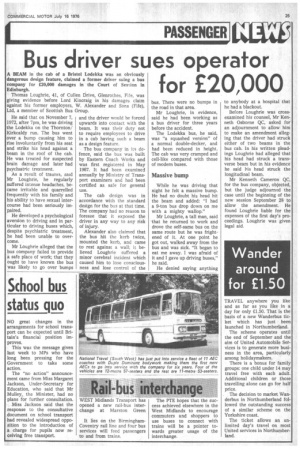Bus driver sues operator
Page 27

If you've noticed an error in this article please click here to report it so we can fix it.
A BEAM in the cab of a Bristol Lodekka was an obviously dangerous design feature, claimed a former driver suing a bus company for £20,000 damages in the Court of Ses.-Aon in Edinburgh.
Thomas Loughrie, 41, of Cullen Drive, Glenrothes, Fife, was giving evidence before Lord Kincraig in his damages claim against his former employers, W. Alexander and Sons (Fife), Ltd, a member of Scottish Bus Group.
He said that on November 7, 1972, after 7pm, he was driving the Lodekka on the Thornton/ Kirkcaldy run. The bus went over a bump causing him to rise involuntarily from his seat and strike his head against a beam in the roof of the cab. He was treated for suspected brain damage and later had psychiatric treatment.
As a result of trauma, said Mr Loughrie, he regularly suffered intense headaches, became irritable and quarrelled frequently with his family and his ability to have sexual intercourse had been seriously impaired.
He developed a psychological aversion to driving and in particular to driving buses which, despite psychiatric treatment, he had been unable to overcome.
Mr Loughrie alleged that the bus company failed to provide a safe place of work; that they ought to have known the bus was likely to go over bumps and the driver would be forced upwards into contact with the beam. It was their duty not to require employees to drive in a cab having such a beam as a design feature.
The bus company in its defence, said the bus was built by Eastern Coach Works and was first registered in May 1967. It had been examined annually by Ministry of Transport examiners and had been certified as safe for general use.
The cab design was in accordance with the standard design for the bus at that time. The company had no reason to foresee that it exposed the driver in any way to any risk of injury, Alexander also claimed that the bus hit the kerb twice, mounted the kerb, and came to rest against a wall; it believed Loughrie suffered a minor cerebral incident which caused him to lose consciousness and lose control of the




































































































